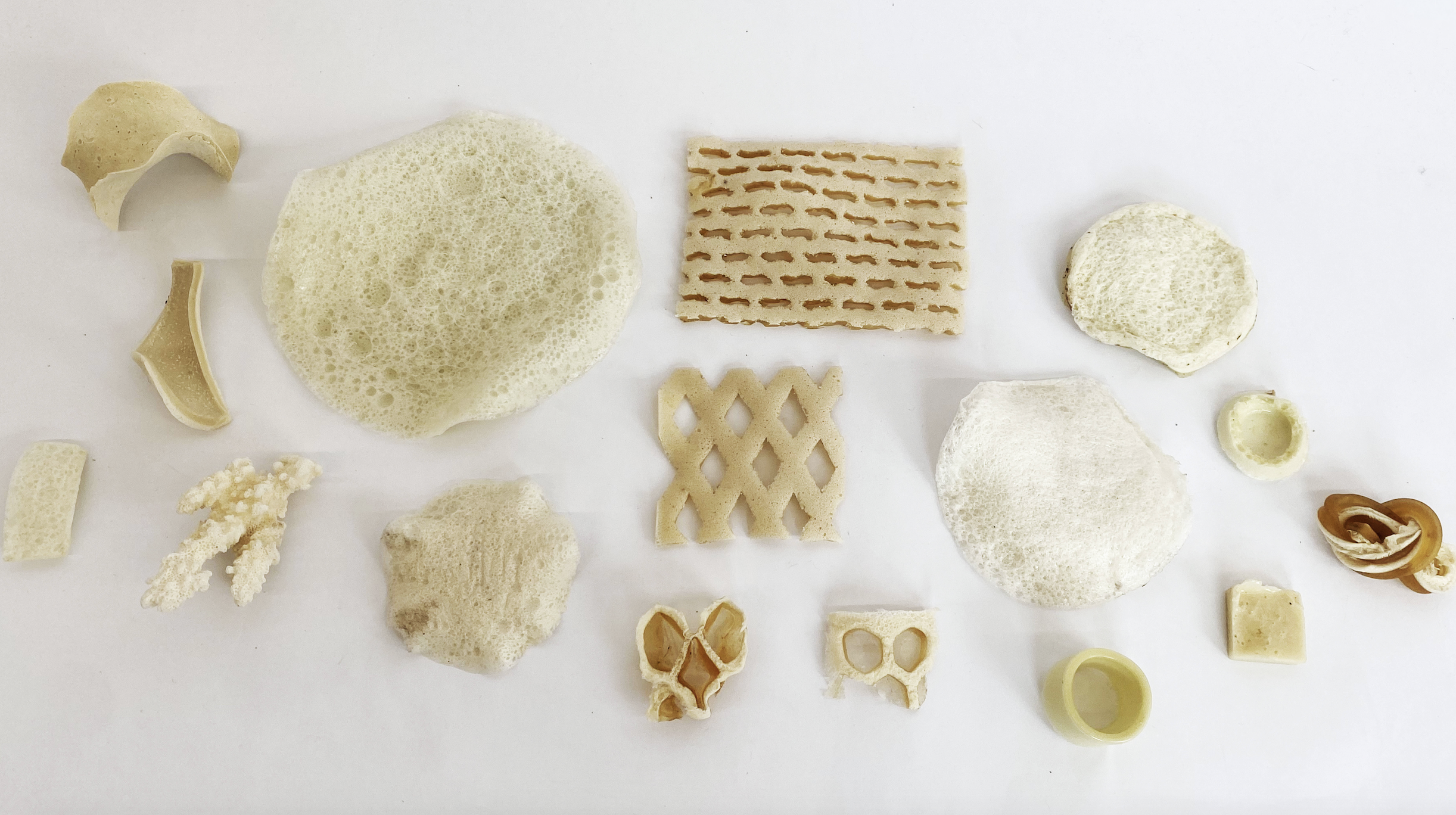
A food and packaging design derived from the biodigestion of styrofoam by the small, but mighty, mealworm. Chitofoam is a biological plastic analogous to polystyrene that is derived from the mealworm’s exoskeleton. Chitofoam is fully backyard-compostable by all six standards.
Patent-Pending

How It Works
Plastic is Produced
Nearly 30% of landfill waste is Styrofoam from packaging and insulation. This waste often ends up in developing nations and is mismanaged. Recycling is possible, but seldom actually practiced due to the process being expensive, difficult and without a real market.
Styrofoam does not biodegrade and instead just fractures into smaller and smaller bits, called “microplastics”. Americans alone throw away roughly 25 billion Styrofoam cups every year. Each of these cups can take up to half a millenia to degrade. The impacts of polystyrene production and pollution are therefore manifold with far-reaching effects on the environment, labor conditions & human health factors.
Plastic is Digested
In 2015, Stanford University researchers discovered that mealworms, small but mighty creatures, could safely digest, and thus biodegrade, Styrofoam. It was discovered that 100 mealworms could eat 40 milligrams of Styrofoam each day with no impact on their health or edibility. In turn, 1 mealworm produces at least 100 milligrams of Chitin. In our studio, we began to dispose of our modelling foam & packaging waste in a homemade mealworm biodigestor for depolymerization. As material developers & designers, we began to collect the exoskeletons that our plastic-eating worms shed and extracted a biopolymer gel called Chitosan.
New Plastic is Created
We extracted Chitosan from the Chitin-rich exoskeletons of mealworms. After much development, we created a lightweight, water-resistant, shock-absorbing & backyard-compostable packaging material analogous to Styrofoam. We are in the process of pushing our replacement “Chitofoam” further by reimagining packaging and designing more efficient, lattice-structured forms for preserving and protecting products.

Selected for the 2022 Lexus Design Award


Enhancing Human Happiness
The production and consumption of Styrofoam hurts numerous life forms: the laborers who actually manufacture it and are exposed to potential mutagens/carcinogens, the mother who finds trace amounts of styrene in her breast milk, the students who eat their food from Styrofoam containers and risk chemical migration/microplastic consumption and the marine life that interacts with the harmful debris.
The durability of Styrofoam as a material is often misaligned with its disposable & single-use product applications. By eliminating the existing non-recyclable Styrofoam and replacing it with a healthy, antifungal and antimicrobial material, we are enhancing the happiness of the aforementioned living beings.
-
Chitofoam anticipates the future global challenges of food scarcity/insecurity, improper waste management and the build-up of microplastics within our ecosystems. An amazing fact about Styrofoam-eating mealworms is that they are still 100% edible by humans. Mealworm farming has been highlighted in recent years as an environmentally-sustainable solution to malnutrition, particularly in developing rural economies.
Growing edible mealworms is affordable, low-resource and space-efficient. The resultant food source is twice as protein efficient as beef (with zero methane emissions). For our proposal, we would like to develop a mealworm protein product made from our plastic-eating mealworms and packaged in our backyard-compostable Chitofilm.
-
We are looking at waste management from an emerging frontier: the possibility of biodigestion and the depolymerization of synthetic plastics by living organisms. Our system takes this material regeneration further by creating a valuable, comparable product out of the degradation. Our Chitofoam highlights the need to confront existing waste and transform it, rather than looking towards virgin materials.
We need to replace a harmful, single-use material with a healthy, regenerative one. In addition to focusing on packaging design innovation, there is an opportunity for the exploration of mealworms as an alternative protein source for a sustainable agricultural and global future.
-
Mealworms are tiny and funny creatures. The imagery of such earthy, wriggling worms munching audibly through one of the most harmful man-made contaminants is also captivating. The solution is unexpected (and seemingly unnatural).
It might be met with excitement or apprehension or awe or skepticism; in any case, the beauty of the design is in letting nature remediate damage, divert waste and create better alternatives with the help of technology & design. The effort to de-stigmatize insect presence in our food and waste systems makes people invested. The familiar tactility of Chitofoam and minimalism of the proposed products draws people in.
So, what’s next?
We are looking for an industry partner in consumer goods to partner with in the creation of luxury packaging. We are particularly interested in closed-loop and take-back models that could turn physical, used products or their packaging into new materials.


